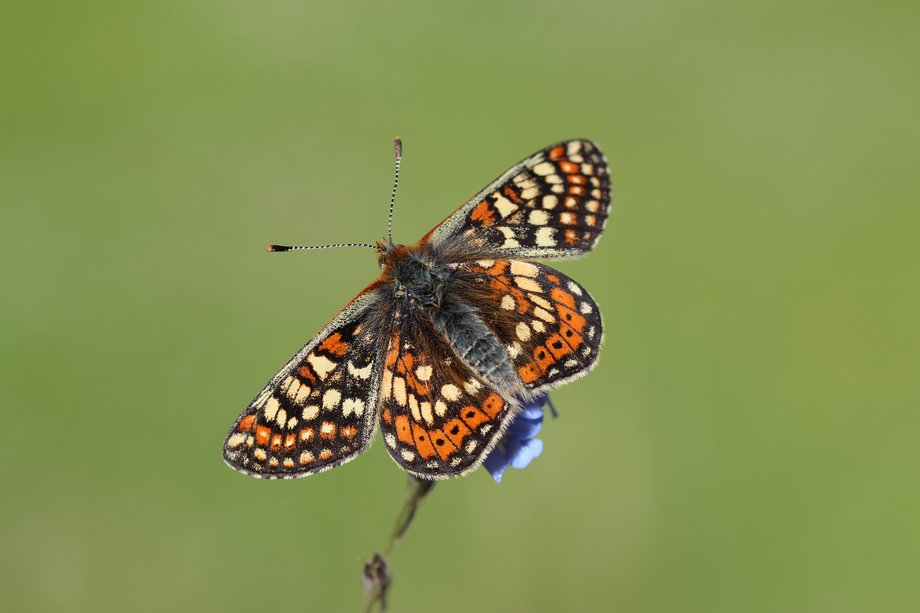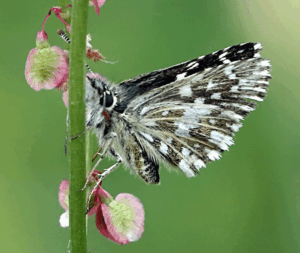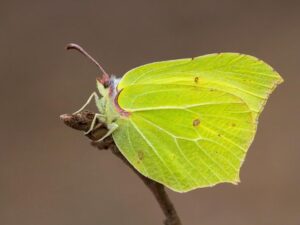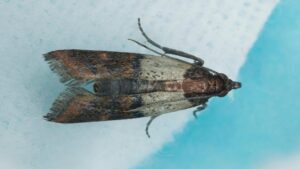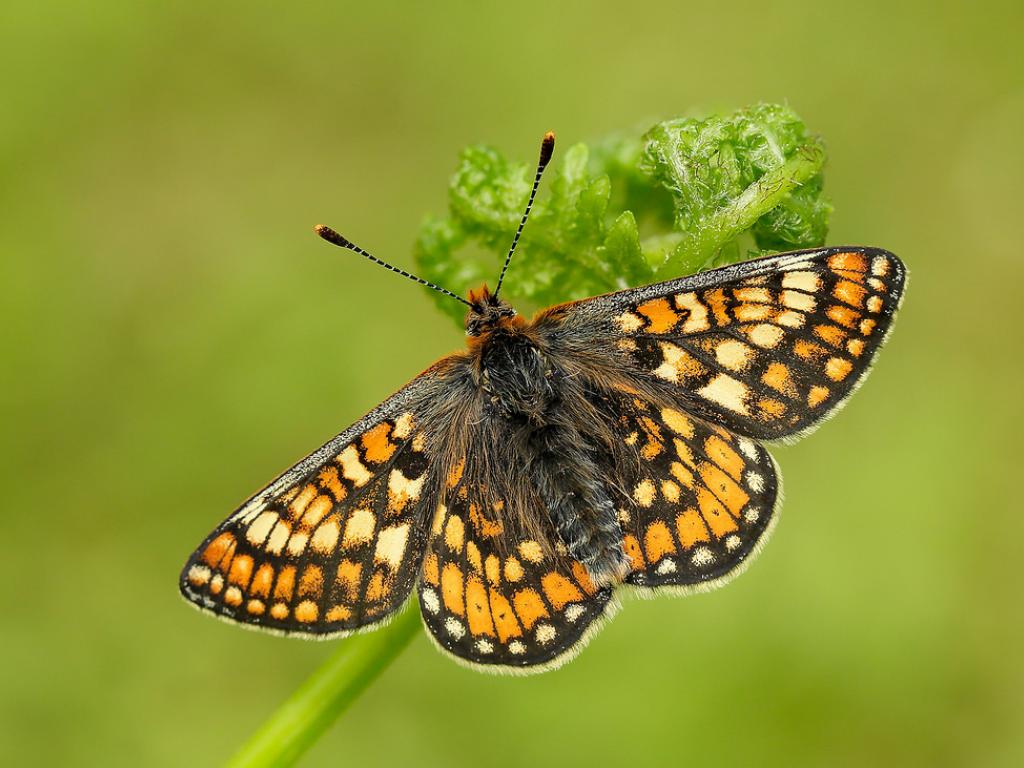
The Marsh Fritillary is threatened, not only in the UK but across Europe, and is, therefore, the object of much conservation effort.
The wings of this beautiful butterfly are more brightly patterned than those of other fritillaries, with more heavily marked races being found in Scotland and Ireland. The larvae spin conspicuous webs that can easily be recorded in late summer.
The Marsh Fritillary was once widespread in Britain and Ireland but has declined severely over the twentieth century. The Marsh Fritillary populations are highly volatile and the species requires extensive habitats or habitat networks for its long term survival. It is now confined to the western side of Britain and Ireland.
Habitat
There are three main habitat types: damp grasslands dominated by tussock forming grasses and chalk grasslands (usually on the west or south-facing slopes in England) and shorter coastal grasslands (in Wales, Scotland and Northern Ireland). Temporary colonies may also exist in large (>1 ha) woodland clearings and in other grasslands.
Size and Family
- Family: Fritillaries
- Size: Medium
- Wing Span Range (male to female) – 42-48mm
Conservation status
- Butterfly Conservation priority: High
- Section 41 species of principal importance under the NERC Act in England
- Listed on Section 7 of the Environment (Wales) Act 2016
- Northern Ireland Priority Species
- Scottish Biodiversity List
- UK BAP: Priority Species
- European status: Vulnerable
- Fully protected under the 1981 Wildlife and Countryside Act
- Fully protected under then 1985 Northern Ireland Wildlife Order
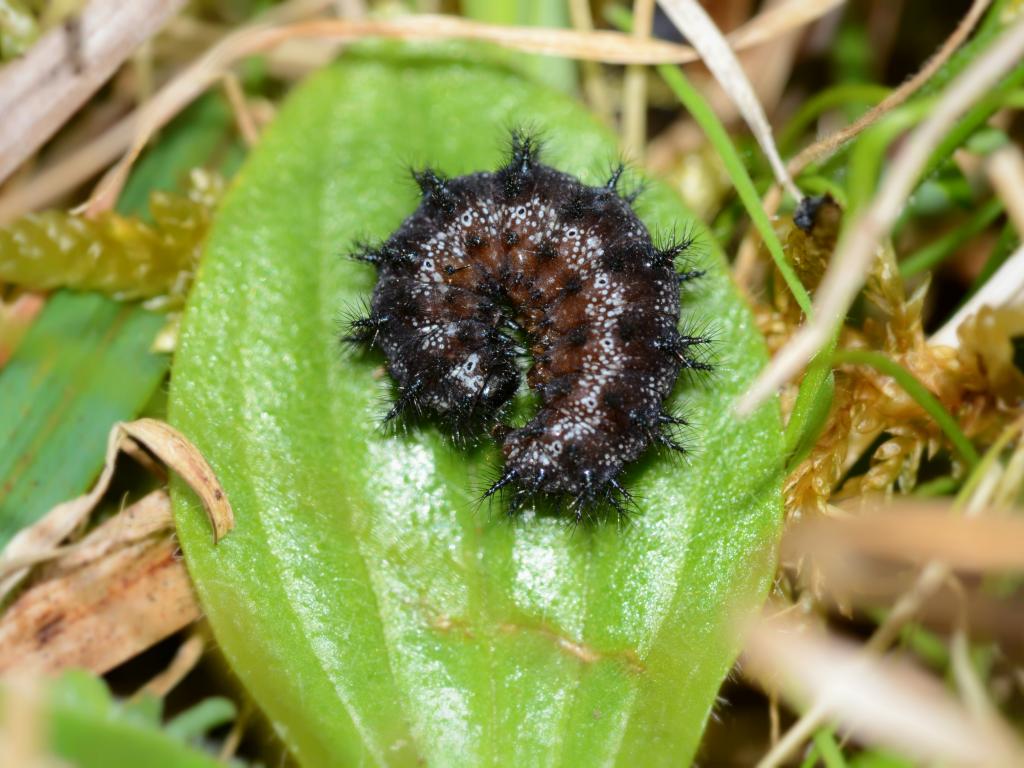
The marsh fritillary (Euphydryas aurinia) is a butterfly of the family Nymphalidae. Commonly distributed in the Palearctic region, the marsh fritillary’s common name derives from one of its several habitats, marshland. The prolonged larval stage lasts for approximately seven to eight months and includes a period of hibernation over the winter. The larvae are dependent on the host food plant Succisa pratensis not only for feeding but also for hibernation, because silken webs are formed on the host plant as the gregarious larvae enter hibernation. Females lay eggs in batches on the host plant and are, like other batch-layers, selective about the location of oviposition because offspring survivorship levels for batch-layers are more tied to location selection than they are for single-egg layers.
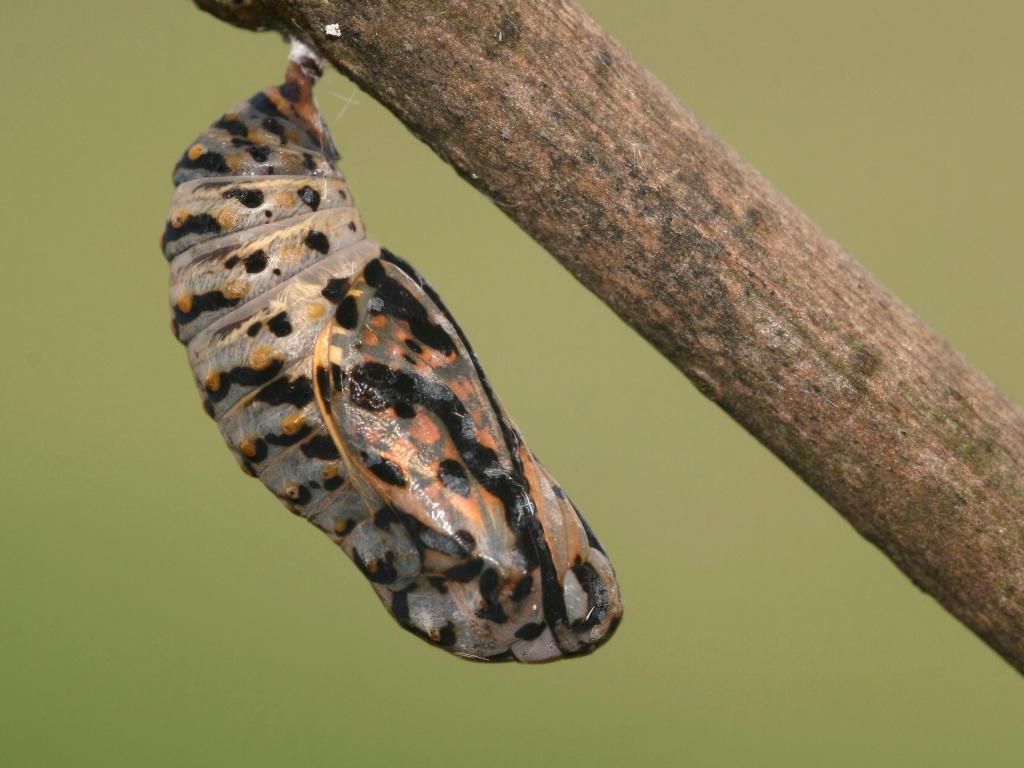
As of 2019 the butterfly’s global conservation status is considered of least concern, but it has faced rapid decline and is considered regionally vulnerable or endangered over much of its range.
The marsh fritillary (Euphydryas aurinia) is a butterfly from the family of brush-footed butterflies (Nymphalidae). Its wingspan ranges from 35mm to 38mm. The marsh fritillary is listed in Annex II of the Habitats Directive and occurs in both wet and dry grasslands. Extensive land use that takes into account the different development stages of the butterfly, the forage plants of its caterpillars (almost exclusively Succisa pratensis in Northern Germany) and the nectar plants of the imagos promotes the populations of the species. In case of excessively extensive land use or long-term fallows, the caterpillar no longer receives enough sunshine and the species disappears. In the long term, the food plant (rosette) also disappears.
The migration of this not very mobile butterfly species is strongly influenced by the landscape structure: along suitable habitat axes, the butterfly can migrate up to 25 km. Extreme events related to climate change such as heavy summer rains or periods of drought can lead to the extinction of small populations, which are then not recolonized due to the lack of habitat connections. General warming in the spring can lead to desynchronization with both feed and nectar plants, so that the proper food resources are not available when the animals need them.
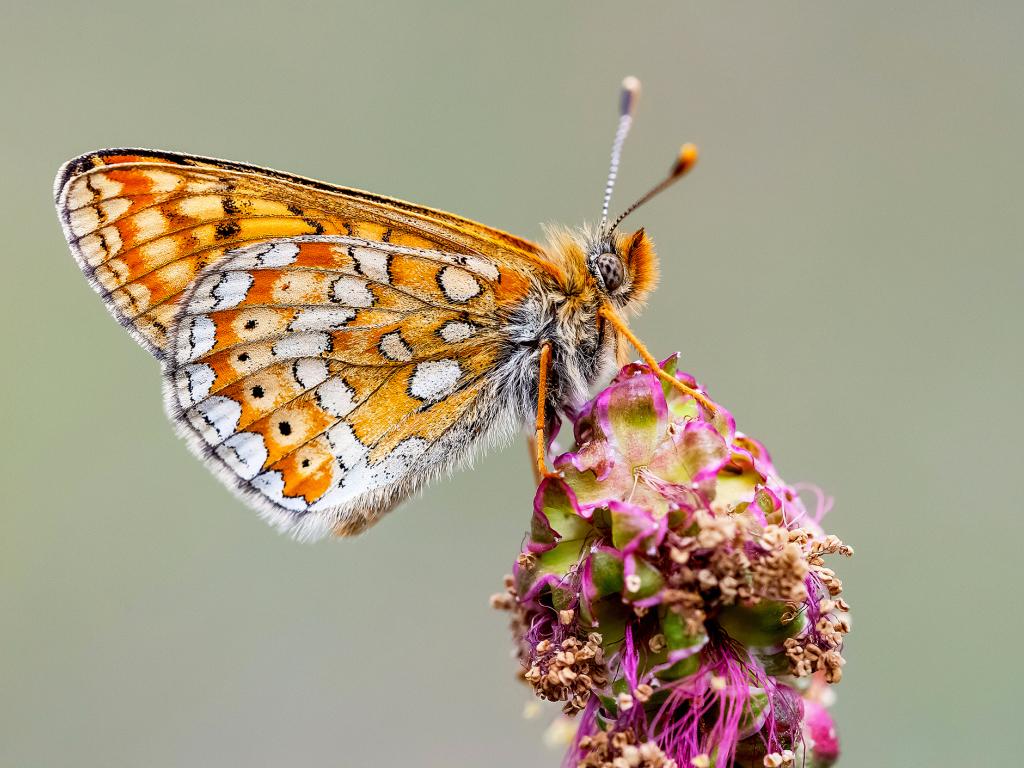
As the name suggests, the marsh fritillary is often found in wet and boggy places, like damp meadows, but can also be seen in a variety of other habitats where there’s plenty of sun and scabious for the caterpillars to feed on. Devil’s-bit scabious is the foodplant of choice, but they will occasionally eat field scabious or small scabious.
The adult butterflies usually begin to emerge in May and can be seen flying into summer. Males will set up small territories, perching on flowers or grass stems and rushing up to meet any passing butterflies in the hope of finding a female. Once a female has mated, she will search for a suitable foodplant and lay a large cluster of eggs on the underside of a leaf – the clusters can contain over 300 eggs!
The eggs hatch after a few weeks and the tiny caterpillars spin a silk web, binding the leaves of the foodplant together. They live communally in these webs, feeding on the leaves. In late summer, they make a new communal web in which to spend the winter. They’ll emerge around March to continue feeding, before pupating in a colourful chrysalis that hangs from a plant.
The marsh fritillary is one of our most threatened butterflies, having suffered severe declines in recent decades both in the UK and more widely in Europe. Local populations can fluctuate greatly from year to year, depending on weather, food availability and the abundance of a parasitic wasp that uses the caterpillars as hosts for its own offspring.
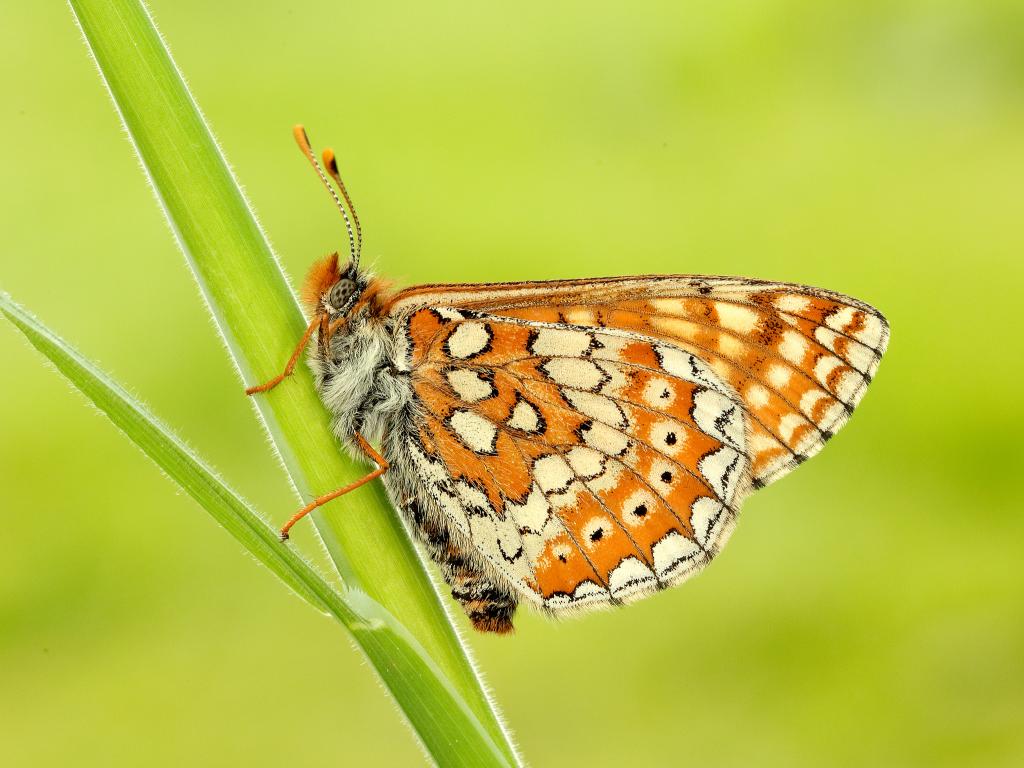
Marsh Fritillary: Habitat, Life Cycle, Diet, and Facts
The Marsh Fritillary (Euphydryas aurinia) is a butterfly belonging to the family Nymphalidae. This species is notable for its strikingly patterned wings and its conservation status, as it has experienced significant declines across its range.
Habitat
The Marsh Fritillary inhabits a variety of grassland environments, primarily:
- Damp Grasslands: These are dominated by tussock-forming grasses and are often found in the western parts of Britain and Ireland.
- Chalk Grasslands: Typically located on west or south-facing slopes in England.
- Coastal Grasslands: Found in Wales, Scotland, and Northern Ireland.
- Woodland Clearings: Occasionally, temporary colonies can be found in large woodland clearings and other grasslands.
Life Cycle
The life cycle of the Marsh Fritillary includes several distinct stages:
- Eggs: Females lay eggs in large batches on the host plants.
- Larvae: The larvae are black and spin conspicuous communal webs. They feed in groups and hibernate over winter in these webs. The larval stage lasts approximately seven to eight months.
- Pupation: After emerging from hibernation in early spring, the larvae continue to feed and eventually pupate on vegetation.
- Adults: The adult butterflies emerge from the pupae and are typically seen flying from late May to late June.
Diet
The primary food plants for the Marsh Fritillary caterpillars are:
- Devil’s-bit Scabious (Succisa pratensis): This is the main food plant.
- Field Scabious (Knautia arvensis) and Small Scabious (Scabiosa columbaria): These are occasionally used, especially in calcareous grasslands.
Facts
- Conservation Status: The Marsh Fritillary is considered vulnerable in Europe and is a high priority for conservation in the UK. It is protected under various national and international laws.
- Distribution: Historically widespread, it is now largely confined to the western parts of Britain and Ireland. It is also found across the Palearctic region from Ireland to Mongolia.
- Population Dynamics: The species is known for its highly volatile populations, often experiencing boom-and-bust cycles due to parasitic wasps that prey on the larvae. This necessitates large, interconnected habitats to ensure long-term survival.
- Conservation Efforts: Conservation strategies include managing grasslands to maintain a mix of short and long vegetation, extensive grazing with cattle or ponies, and careful habitat management to prevent overgrowth and maintain the necessary plant diversity.
The Marsh Fritillary is a beautiful and ecologically significant butterfly that requires ongoing conservation efforts to prevent further declines and ensure its survival across its natural habitats.

